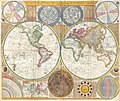Файл:1794 Samuel Dunn Wall Map of the World in Hemispheres - Geographicus - World2-dunn-1794.jpg
Перейти до навігації
Перейти до пошуку

Розмір при попередньому перегляді: 712 × 600 пікселів. Інші роздільності: 285 × 240 пікселів | 570 × 480 пікселів | 912 × 768 пікселів | 1216 × 1024 пікселів | 2431 × 2048 пікселів | 6000 × 5054 пікселів.
Повна роздільність (6000 × 5054 пікселів, розмір файлу: 8,92 МБ, MIME-тип: image/jpeg)
Історія файлу
Клацніть на дату/час, щоб переглянути, як тоді виглядав файл.
| Дата/час | Мініатюра | Розмір об'єкта | Користувач | Коментар | |
|---|---|---|---|---|---|
| поточний | 20:01, 1 червня 2012 |  | 6000 × 5054 (8,92 МБ) | Brandmeister~commonswiki | Reverted to version as of 04:17, 23 March 2011 |
| 16:15, 19 травня 2012 |  | 6000 × 5054 (27,38 МБ) | Brandmeister~commonswiki | contrast | |
| 04:17, 23 березня 2011 |  | 6000 × 5054 (8,92 МБ) | BotMultichillT | {{subst:User:Multichill/Geographicus |link=http://www.geographicus.com/P/AntiqueMap/World2-dunn-1794 |product_name=1794 Samuel Dunn Wall Map of the World in Hemispheres |map_title=A General Map of the World, or Terraqueouis Globe with all the New Discover |
Використання файлу
Такі сторінки використовують цей файл:
Глобальне використання файлу
Цей файл використовують такі інші вікі:
- Використання в alt.wikipedia.org
- Використання в ar.wikipedia.org
- Використання в av.wikipedia.org
- Використання в br.wiktionary.org
- Використання в ckb.wikipedia.org
- Використання в cv.wikipedia.org
- Використання в de.wikipedia.org
- Використання в en.wikipedia.org
- Early world maps
- History of cartography
- Southern Ocean
- Samuel Dunn (mathematician)
- Wikipedia:Featured picture candidates/1794 Samuel Dunn Map
- A General Map of the World, or Terraqueous Globe
- Wikipedia:Featured picture candidates/June-2012
- User:Cruickshanks/sandbox2
- Wikipedia:Featured picture candidates/March-2014
- Wikipedia:Featured picture candidates/1794 Samuel Dunn Wall Map of the World in Hemispheres - Geographicus - World2-dunn-1794.jpg (review)
- User:Setvina/be bold
- Portal:Maps
- User:Sarangem
- User:Jacobwilder427
- Використання в en.wiktionary.org
- Використання в eo.wikipedia.org
- Використання в et.wikipedia.org
- Використання в eu.wikipedia.org
- Використання в fa.wikipedia.org
- ویکیپدیا:نگارههای برگزیده/نقشه
- ویکیپدیا:گزیدن نگاره برگزیده/ژوئن-۲۰۱۲
- نقشه ساموئل دان
- ویکیپدیا:گزیدن نگاره برگزیده/1794 Samuel Dunn Wall Map of the World in Hemispheres - Geographicus - World2-dunn-1794.jpg
- ویکیپدیا:نگاره روز/اکتبر ۲۰۱۲
- الگو:نر/2012-10-03
- الگو:نر محافظت شده/2012-10-03
- بحث کاربر:Alborzagros/بایگانی ۷
- Використання в fr.wikipedia.org
- Використання в fr.wikiversity.org
- Використання в gl.wikipedia.org
- Використання в hu.wikipedia.org
- Використання в hy.wikipedia.org
Переглянути сторінку глобального використання цього файлу.
